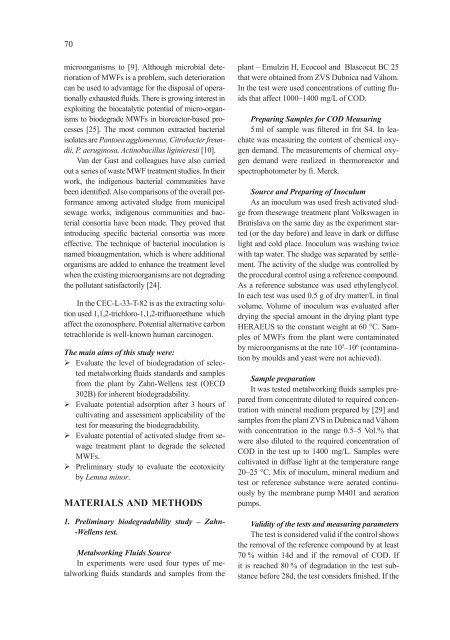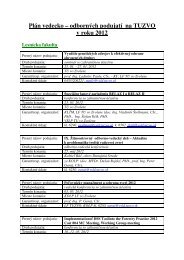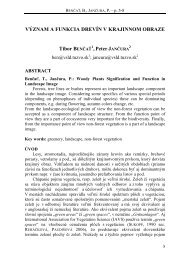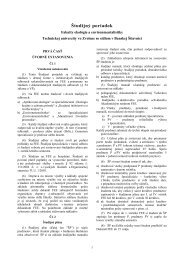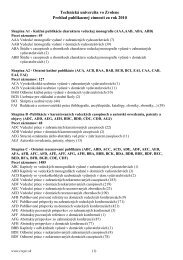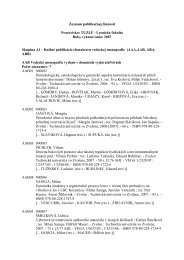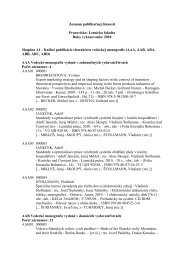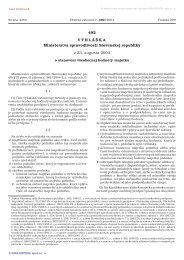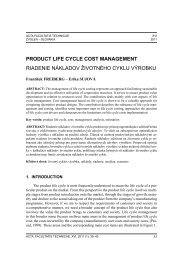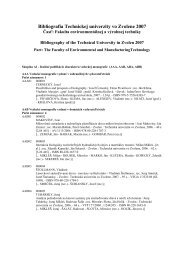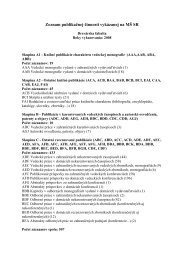69BiodegradabilityThe great variety of biodegradation processesin the natural environment and in the technicalplants for treating waste water and solid wastesgave rise to a rather large number of test methodsbased on different test principles [16].Biodegradability of lubricant industry recognizedthe following test OECD 301 B – ModifiedSturm test, ASTM D 5864 Standard Test Methodfor Determining Aerobic Aquatic Biodegradationof Lubricants and CEC L-33-T-82 Biodegradabilityof Two-Stroke Cycle Outboard engine Oils inCH 2groups Water [17, 3], and approved the testmethod CEC-L-33-A-93 (1995) [18, 19, 5, 20]. In2005/360/ES the biodegradability shall be determinedfor each constituent substance in the lubricantseparately by test methods specified as OECD301 A–F for readily biodegradation [1] and OECD302 C or ISO 14 593 (CO 2headspace test) for inherentlybiodegradable substances [8]. In [5] is forevaluating biodegradability cited also OECD 302B – Zahn-Wellens test.Screening tests for ready biodegradability(OECD 301 A-F) indicate if a compound is degradableunder natural conditions without any problem[22, 23]. The biodegradation is monitored as thedegree of mineralization, by means of summaryparameters such as oxygen uptake, carbon dioxideproduction or elimination of dissolved organiccarbon (DOC). Without employing 14 C techniquesthis is only possible if the test compound is the solecarbon and energy source for microorganisms. Thetest duration is 28 days, allowing some adaptationof the microorganisms to the compound butmineralization as a test criterion adds some extrastringency as it prevents chemicals to pass the testwhich are only converted into persistent products[22]. These informative tests basically discriminatereadily biodegradable compounds from others, butthey often underestimate the potentiality of degradationin environmental systems. Therefore whenthe result is negative, inherent (potential) biodegradabilitytests are required [23].Many lubricants, particularly those based onmineral oils, are not readily biodegradable and dataon their inherent biodegradability (i.e. potential tobe biodegraded) is perhaps more useful when assessingtheir likely environmental impact. There arecurrently three internationally accepted guidelinesfor assessing inherent biodegradability: OECD 302A (`Modified SCAS Test’, Inherent Biodegradability,1981a), OECD 302 B (Zahn-Wellens/EMPATest, 1992) and OECD 302 C (`Modified MITI IITest’, Inherent Biodegradability, 1981b). However,two of these tests (OECD 302 A and B) measurebiodegradation as the loss of DOC and are thereforeunsuitable for testing lubricants which usuallyhave a very low solubility in water (however, inOECD 302B biodegradation can be realized alsowith COD) [18]. However, this method is not suitablefor testing substances that are poorly soluble,<strong>vo</strong>latile or adsorb to activated sludge, since theDOC or COD analysis it encompasses does not allowa clear differentiation between biodegradationand elimination by abiotic processes. Modificationof the Zahn-Wellens test by continuous measurementof oxygen consumption (pressure measurement)and carbon dioxide (conductivity measurement)production was discussed in [26, 27]. It isa closed test system consisting of a culture flask,a carbon dioxide adsorption flask, a pump as wellas integrated measuring and control instruments.The air circulating within the test system causesthe carbon dioxide present in the test solution tobe striped out completely and directly absorbed bythe adsorption solution. This new test system alsofacilitates to test poorly soluble, adsorbing and<strong>vo</strong>latile substances for inherent biodegradabilityand constitutes an appropriate complement to thestandardized Zahn-Wellens test [26].The third test (OECD 302 C) measures biodegradationas O 2uptake and could therefore beapplied to insoluble substances. However, with theexception of Japan, the OECD 302 C is reported tohave hasfallen into disuse, and has technical limitationsconcerning the need for a ThOD value anda (needlessly) complex inoculum [18].BioremediationTo conform to all European legislation all spentmetalworking fluids are to be disposed of as hazardouswaste. The internal disposal of used emulsionsvia the waste water is not allowed; thereforeall used metal working fluids as well as cleaningwater are disposed of as waste [28].The wide variety of organic MWFs constituents,which are susceptible to biodegradation partiallyor in whole, and the presence of water renderO/W emulsions an ideal environment for some
70microorganisms to [9]. Although microbial deteriorationof MWFs is a problem, such deteriorationcan be used to advantage for the disposal of operationallyexhausted fluids. There is growing interest inexploiting the biocatalytic potential of micro-organismsto biodegrade MWFs in bioreactor-based processes[25]. The most common extracted bacterialisolates are Pantoea agglomeraus, Citrobacter freundii,P. aeruginosa, Actinobacillus liginieresii [10].Van der Gast and colleagues have also carriedout a series of waste MWF treatment studies. In theirwork, the indigenous bacterial communities havebeen identified. Also comparisons of the overall performanceamong activated sludge from municipalsewage works, indigenous communities and bacterialconsortia have been made. They proved thatintroducing specific bacterial consortia was moreeffective. The technique of bacterial inoculation isnamed bioaugmentation, which is where additionalorganisms are added to enhance the treatment levelwhen the existing microorganisms are not degradingthe pollutant satisfactorily [24].In the CEC-L-33-T-82 is as the extracting solutionused 1,1,2-trichloro-1,1,2-trifluoroethane whichaffect the ozonosphere. Potential alternative carbontetrachloride is well-known human carcinogen.The main aims of this study were:‣ Evaluate the level of biodegradation of selectedmetalworking fluids standards and samplesfrom the plant by Zahn-Wellens test (OECD302B) for inherent biodegradability.‣ Evaluate potential adsorption after 3 hours ofcultivating and assessment applicability of thetest for measuring the biodegradability.‣ Evaluate potential of activated sludge from sewagetreatment plant to degrade the selectedMWFs.‣ Preliminary study to evaluate the ecotoxicityby Lemna minor.MATERIALS AND METHODS1. Preliminary biodegradability study – Zahn--Wellens test.Metalworking Fluids SourceIn experiments were used four types of metalworkingfluids standards and samples from theplant – Emulzin H, Ecocool and Blascocut BC 25that were obtained from ZVS Dubnica nad Váhom.In the test were used concentrations of cutting fluidsthat affect 1000–1400 mg/L of COD.Preparing Samples for COD Measuring5 ml of sample was filtered in frit S4. In leachatewas measuring the content of chemical oxygendemand. The measurements of chemical oxygendemand were realized in thermoreactor andspectrophotometer by fi. Merck.Source and Preparing of InoculumAs an inoculum was used fresh activated sludgefrom thesewage treatment plant Volkswagen inBratislava on the same day as the experiment started(or the day before) and leave in dark or diffuselight and cold place. Inoculum was washing twicewith tap water. The sludge was separated by settlement.The activity of the sludge was controlled bythe procedural control using a reference compound.As a reference substance was used ethylenglycol.In each test was used 0.5 g of dry matter/L in final<strong>vo</strong>lume. Volume of inoculum was evaluated afterdrying the special amount in the drying plant typeHERAEUS to the constant weight at 60 °C. Samplesof MWFs from the plant were contaminatedby microorganisms at the rate 10 5 –10 6 (contaminationby moulds and yeast were not achieved).Sample preparationIt was tested metalworking fluids samples preparedfrom concentrate diluted to required concentrationwith mineral medium prepared by [29] andsamples from the plant ZVS in Dubnica nad Váhomwith concentration in the range 0.5–5 Vol.% thatwere also diluted to the required concentration ofCOD in the test up to 1400 mg/L. Samples werecultivated in diffuse light at the temperature range20–25 °C. Mix of inoculum, mineral medium andtest or reference substance were aerated continuouslyby the membrane pump M401 and aerationpumps.Validity of the tests and measuring parametersThe test is considered valid if the control showsthe removal of the reference compound by at least70 % within 14d and if the removal of COD. Ifit is reached 80 % of degradation in the test substancebefore 28d, the test considers finished. If the
- Page 2 and 3:
Acta FacultatisEcologiaeJournal of
- Page 4 and 5:
OBSAH / CONTENTSISOL M., MICHALÍKO
- Page 6:
5ACTA FACULTATIS ECOLOGIAE, 16: Sup
- Page 12:
11ACTA FACULTATIS ECOLOGIAE, 16: Su
- Page 18 and 19:
17ACTA FACULTATIS ECOLOGIAE, 16: Su
- Page 20 and 21: 19are lower in ill patients compare
- Page 22: 21are considered as the most accura
- Page 25 and 26: 24- multimode cavities are usually
- Page 27 and 28: 26the load during its exposure to f
- Page 29 and 30: 28Tradescantia paludosa 02 test and
- Page 31 and 32: 30Tab. 5: Results of positive contr
- Page 34 and 35: 33ACTA FACULTATIS ECOLOGIAE, 16: Su
- Page 36 and 37: 35DISCUSSIONThe ionising radiation
- Page 38 and 39: 37ACTA FACULTATIS ECOLOGIAE, 16: Su
- Page 40 and 41: 39222Rn is produced by radioactive
- Page 42 and 43: 41180160140this reason we also pick
- Page 44: 435001450400350hKz0,8h [m]300250200
- Page 47 and 48: 46deposit is that stripped in off-l
- Page 49 and 50: 48TruenessTrueness was determined i
- Page 51 and 52: 50MATERIAL AND METHODSChloroform (p
- Page 53 and 54: 52absorbance [a.u.]1,000,750,500,25
- Page 55 and 56: 54Tab. 1: Rrequirements determinati
- Page 57 and 58: 56Methods of VOC testing were set a
- Page 60 and 61: 59Tab. 6: ContinuedSamples withsurf
- Page 62 and 63: 61ACTA FACULTATIS ECOLOGIAE, 16: Su
- Page 64 and 65: 63One of the possible explanations
- Page 66 and 67: 65Ai - Ai-1 [Bq.m -3 ]86420-2-4-6-8
- Page 68 and 69: 67ACTA FACULTATIS ECOLOGIAE, 15: Su
- Page 72 and 73: 71degradation starts of late days,
- Page 74 and 75: 73Fig. 4 Treated (after 28 days of
- Page 76: 75parameters of the cutting process
- Page 80 and 81: 79Fraction: D (residual rest) prese
- Page 82: 81was not confirmed. Maximum of mer
- Page 85 and 86: 84Fig. 1 Schematic diagram of atomi
- Page 87 and 88: 86Alpha spectrometryAlpha spectrome
- Page 89 and 90: 8880007000y = 6622xR 2 = 0.939SIMS
- Page 92 and 93: 91ACTA FACULTATIS ECOLOGIAE, 16: Su
- Page 94 and 95: 93Gemer according to the German mod
- Page 96 and 97: 95Tab. 1 Results of the chemical an
- Page 98 and 99: 97Continuation of Tab. 2 Results of
- Page 100 and 101: 99Vlčia Dolina and from the reserv
- Page 102 and 103: 101ACTA FACULTATIS ECOLOGIAE, 16: S
- Page 104 and 105: 103mg.dm -3mg.dm -35,004,003,002,00
- Page 106 and 107: 105year and the average value repre
- Page 108 and 109: 107ACTA FACULTATIS ECOLOGIAE, 16: S
- Page 110 and 111: 109Sample site 1 Sample site 2 Samp
- Page 112 and 113: 111As for the sampling time (Fig. 5
- Page 114 and 115: 113ACTA FACULTATIS ECOLOGIAE, 16: S
- Page 116 and 117: 115Typha latifolia, Carex sp., Scir
- Page 118 and 119: 117conditions for decomposition of
- Page 120 and 121:
119ACTA FACULTATIS ECOLOGIAE, 16: S
- Page 122 and 123:
121from the background (derived fro
- Page 124 and 125:
12311. PETROVSKÝ, E., ELWOOD, B.:
- Page 126 and 127:
125ACTA FACULTATIS ECOLOGIAE, 16: S
- Page 128 and 129:
1272.52.0Correlation coefficient 0,
- Page 130 and 131:
129ACTA FACULTATIS ECOLOGIAE, 16: S
- Page 132 and 133:
131RESULTS AND DISCUSSIONTable 2 gi
- Page 134 and 135:
133ACTA FACULTATIS ECOLOGIAE, 16: S
- Page 136 and 137:
135V-1 BOREHOLEThe courses of 222 R
- Page 138 and 139:
137AV-2 (40m) 2006A ( 222 Rn) [kBq/
- Page 140 and 141:
139soaks into the soil, another par
- Page 142 and 143:
141ACTA FACULTATIS ECOLOGIAE, 16: S
- Page 144 and 145:
143Fig. 2 The continuous monitoring
- Page 146 and 147:
145Indoor radon activity concentrat
- Page 148 and 149:
147ACTA FACULTATIS ECOLOGIAE, 16: S
- Page 150 and 151:
149Fig. 1 Podlipa dump-fieldCanada)
- Page 152 and 153:
151concentrations of Fe. Cu. Cd. Ni
- Page 154 and 155:
153DUMP-FIELDREFERENCE SITEppm15001
- Page 156 and 157:
155Fig. 5 Compression of wood forma
- Page 158 and 159:
157decrease in the following order:
- Page 160 and 161:
159ACTA FACULTATIS ECOLOGIAE, 16: S
- Page 162 and 163:
161SPECIFIC EXAMPLES OFFACTORS THAT
- Page 164 and 165:
163ACTA FACULTATIS ECOLOGIAE, 16: S
- Page 166 and 167:
165The methods developed to incorpo
- Page 168 and 169:
167The effects of wind on ozone con
- Page 170 and 171:
169Fig. 6 Mean total and stomatal f
- Page 172 and 173:
171transport modelling in North Ame
- Page 175:
Acta Facultatis Ecologiae, Volume 1


